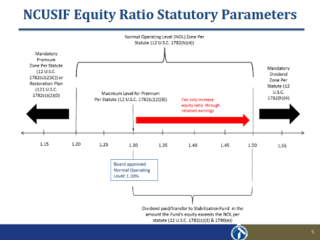Ringing in the New Year (With a 2017 NCUSIF Premium Charge?)
Written by Pamela Yu, Special Counsel for Compliance and Research
At the NCUA Board's monthly meeting in November, the agency indicated that a National Credit Union Share Insurance Fund (NCUSIF) premium charge for all federally-insured credit unions (FICUs) may be necessary in 2017 due to a continuing downward trend of the NCUSIF equity ratio. The agency provided additional details about its 2017 share insurance premium range recommendations set in the December 2016 NCUA Report, which was published on NCUA's website yesterday. NAFCU opposes any unnecessary premium charges and has been communicating with NCUA to express our members concerns about potential charges in 2017. We are strongly urging NCUA to consider all means to mitigate the need for a premium. While NAFCU is hopeful that a premium will not be necessary in 2017, if the agency decides to move forward with a premium charge, NAFCU will continue working to ensure our members have the information and guidance they need to properly plan for this expense.
Although a premium charge is not certain, many credit unions are already taking steps to address the possibility of a 2017 premium. One question that has come up is whether Generally Accepted Accounting Principles (GAAP) requires credit unions to immediately recognize a loss on their balance sheets.
By way of brief background, the NCUSIF equity ratio is a general measure of the health of the NCUSIF. The equity ratio is calculated as the sum of FICU's capital contribution of one percent of insured shares and the fund's retained earnings, divided by total insured shares. The four primary drivers that impact the equity ratio are: investment returns, insurance losses, insured share growth, and expense growth.
The Federal Credit Union Act requires the NCUA Board to specify a normal operating level for the NCUSIF, falling somewhere between 1.20 percent and 1.50 percent. Since 2007, the Board-approved normal operating level for the equity ratio has been 1.30 percent. To keep the fund at its normal operating level, the Board may charge a premium if the equity ratio falls below 1.30 percent, but a premium is not mandatory unless the equity ratio is below 1.20 percent. NCUA has provided a handy diagram to illustrate the statutory parameters of the NCUSIF equity ratio:
According to NCUA, the growth in credit unions insured shares coupled with the continued low interest rate environment has resulted in a steady decline in the equity ratio. Based on current projections, the equity ratio is expected to fall to between 1.24 percent and 1.27 percent in 2017. It is important to note that, even under the agency's most adverse modeling scenario, NCUA does not anticipate that the equity ratio will fall below the statutory minimum of 1.2 percent in 2017. Thus, a premium charge is not required under federal law. However, assuming it will continue to be difficult to generate sufficient retained earnings in the current interest rate environment, in order to bring the equity ratio up to 1.30 percent, NCUA is projecting that the Board will likely need to charge a premium for 2017 of three to six basis points to return the equity ratio to its normal operating level.
While GAAP is within accounting professionals' expertise rather than legal expertise, under GAAP, a credit union should recognize a liability if:
- It is probable that a liability has been incurred; and
- The amount of the loss can be reasonably estimated.
Given that NCUA is reasonably estimating that at least a 3 basis point premium is probable in 2017, several of NAFCU's members have asked if GAAP requires the credit union to immediately recognize a loss.
Based on informal conversations with agency staff, the answer is no.
NCUA has indicated that a premium is expensed immediately when specified. In 2010, the last time credit unions were charged an NCUSIF premium, NCUA instructed in Letter to Credit Unions 10-17 that credit unions using the accrual basis of accounting should calculate the amount of the premium and record the premium on the next Call Report after the premium was charged as a Member Insurance expense (Call Report Account Code 310). Since that time, however, NCUA has broken that account code into several sub-accounts and it would now go under NCUSIF Premium Expense (Call Report Account Code 311A).
In short, credit unions do not have to recognize a premium expense until and unless the Board specifies an exact premium amount and approves it at a Board meeting. For more information on GAAP requirements, credit unions may need to consult with their accountant.
To avoid confusion, NAFCU is urging NCUA to clearly communicate that credit unions do not have to start accounting for the 2017 premium until the agency takes official action to charge an exact premium.
In the meantime, NAFCU will continue to oppose any unnecessary premiums and encourage the agency to publicly and transparently explore all available avenues to negate the need for a premium in the New Year.
***
NCUA Board to Hear Briefing on NGN Legacy Asset Disposition Strategy
On a related note, the NCUA Board meets tomorrow for its final public meeting of 2016. Included on the Board's agenda is a briefing on the agency's disposition strategy for the NCUA Guaranteed Note (NGN) Legacy Assets. The Legacy Assets are distressed investment securities held by the Asset Management Estates (AMEs) of the five corporate credit unions that failed during the economic crisis. Tomorrow's board briefing may provide additional information as to the timing of potential rebates and capital recoveries that may become available to insured credit unions from the Temporary Corporate Credit Union Stabilization Fund (Stabilization Fund). Read NAFCU's FAQs about the Stabilization Fund here.

